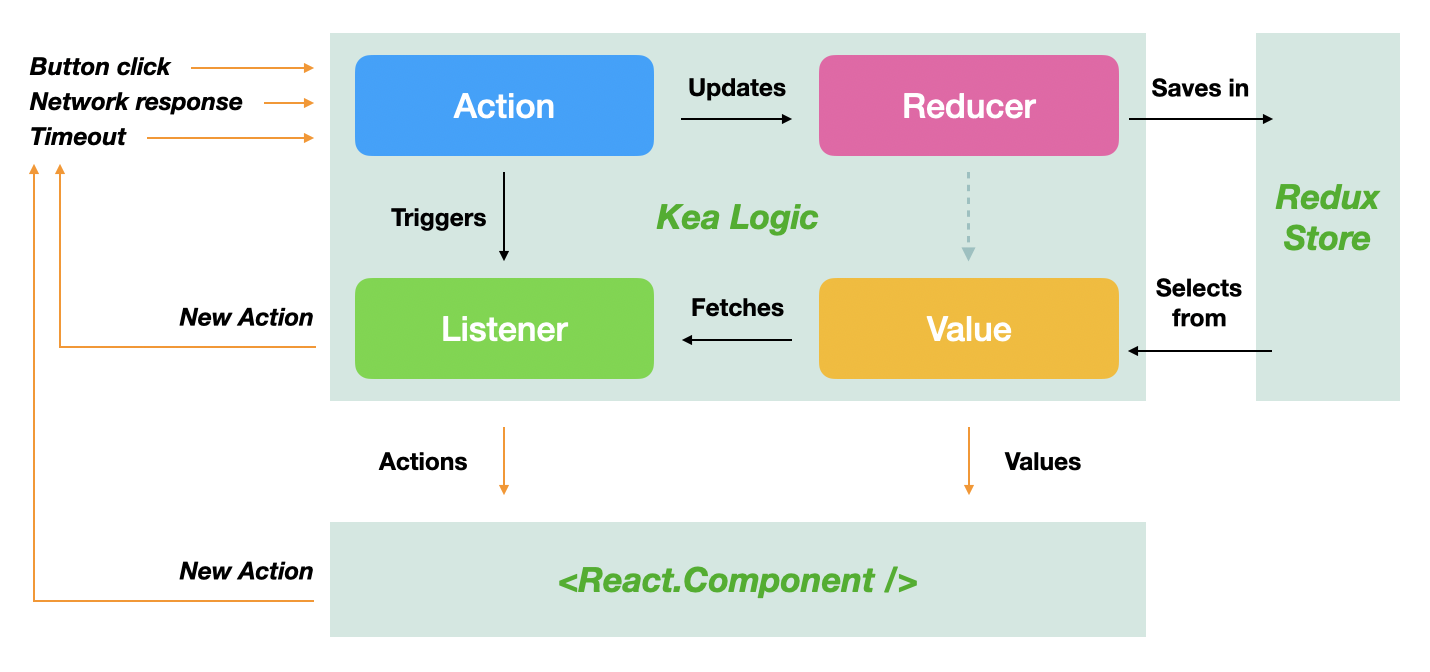What is Kea?
note
If you just want to see some code, see the quickstart or the Github API tutorial
Introduction#
Kea is a production-grade state management framework built for ambitious React apps.
It scales really well as your application grows and helps keep your state neat and clean.

Kea is built on top of Redux and leverages its underlying functional principles.
- Every operation in your app starts with an action (increment counter).
- These actions update reducers (counter) that hold the actual data.
- This data is stored in a global state, which is managed by Redux.
- You fetch values (counter is 1) through selectors (find the counter in the state) from this state.
- Actions may also trigger listeners, which are plain async functions that talk with externals APIs, read values or dispatch other actions.
- All related actions, reducers, selectors and listeners are grouped into a logic (counterLogic).
- React Components connect to this logic and pull in all needed actions and values.
Check out the quickstart to see this as code or read the installation instructions to get started.
What is Kea good for?#
First, Kea is not just a place to put your app's data. It's actually a framework for managing the complete lifecycle of this data. This includes only mounting logic that is actively in use by React and keeping the rest in standby, freeing up precious resources.
Unlike some other state management libraries, where you statically connect all your reducers to the
store (const store = configureStore({ reducer: combinedReducers })) or
read state through hardcoded global variables (const todos = useStoreState(state => state.todos.items)),
you don't need to worry about this in Kea. The framework does it for you.
Logic in Kea is always connected to your React components (and to other logic) via regular
import statements (import { logic } from './logic') and mounted only when requested
by a component (const { increment } = useActions(logic)).
Logic that is no longer in use is automatically unmounted, freeing up memory.
This makes Kea perfect for large apps with complex relationships between state and components. This also means that code-splitting works out of the box with Kea. No patchwork required.
Second, Kea's logic exposes a very complete interface that you can use from
anywhere. Need to have one logic's listeners access another logic's values? Not a problem!
Everything follows a consistent interface and is designed for interoperability.
Third, Kea is not a theoretical project. It's built by people who build complex applications for a living. Kea has been used in several large projects, which consist of hundreds of logics that cover thousands of components. It has scaled really well every time!
Finally, Kea's functionality is not set in stone. Whenever you find yourself writing repetitive code, you may abstract it away into a plugin. In fact, Kea's core is actually implemented as a plugin itself. There are plugins for routing, offline storage, sagas, websockets and much more. This opens up whole new ways to build applications.
What is Kea not good for?#
All that said, there are few cases when you should not consider using Kea.
First, if you have a large app with an existing state management solution that works reasonably well,
switching to Kea might cost more than it's worth. This might especially be the case if your entire app
is built around GraphQL/Apollo or another complete ecosystem.
Very tiny apps might also do fine with just React's useState, but as soon as you need
to share logic between components, it's wise to evaluate real state management solutions.
Second, Kea is rather opinionated and wants you to follow some functional programming principles. Mainly
this means that you should never modify existing state (state.push(newElement)), but must always create
new state (state = [...state, newElement]). Instead of abstracting away these details from the end-user,
like some libraries do with immer, Kea embraces
this style of writing code. I believe the time spent learning a bit of functional programming
is absolutely worth it and will make you into a better programmer
overall. That said, this style is not for everyone.
Third, did I mention Kea is opinionated? Sometimes it may be too explicit for your taste (having to explicitly define actions for example), sometimes it might be too implicit or too magical. There is thought put into each decision that went into Kea, taking into account developer happiness (neat and clean code that just works) and developer productivity (limiting bugs). It's a tight rope to walk, yet I believe Kea strikes a beautiful balance. You might disagree. If so, open an issue and let's debate!
How does Kea compare to other frameworks?#
That's a good question! Join the discussion here!
Why "kea"?#
According to Wikipedia:
The kea (/ˈkiːə/; Māori: [kɛ.a]) is a species of large parrot found in the forested and alpine regions of the South Island of New Zealand.
Kea are known for their intelligence and curiosity. Kea can solve logical puzzles, such as pushing and pulling things in a certain order to get to food, and will work together to achieve a certain objective.
Check out some videos to see this magnificent bird in action.
Kea the parrot always finds the shortest and the smartest way to achieve a goal, such as getting food from a maze.
Kea the framework follows a similar approach. It offers a simple and straightforward solution to the complicated problem of state management.
Plus, when I started to learn React, I was on a plane back to Belgium from a holiday in New Zealand, having just seen the bird a week before. Thus I find the name strangely fitting.
Next Steps
- Read quickstart if you're in a hurry, otherwise...
- Read core concepts to get a good technical overview of what makes Kea tick and why. It includes everything in the quickstart.
 Kea 2.6
Kea 2.6